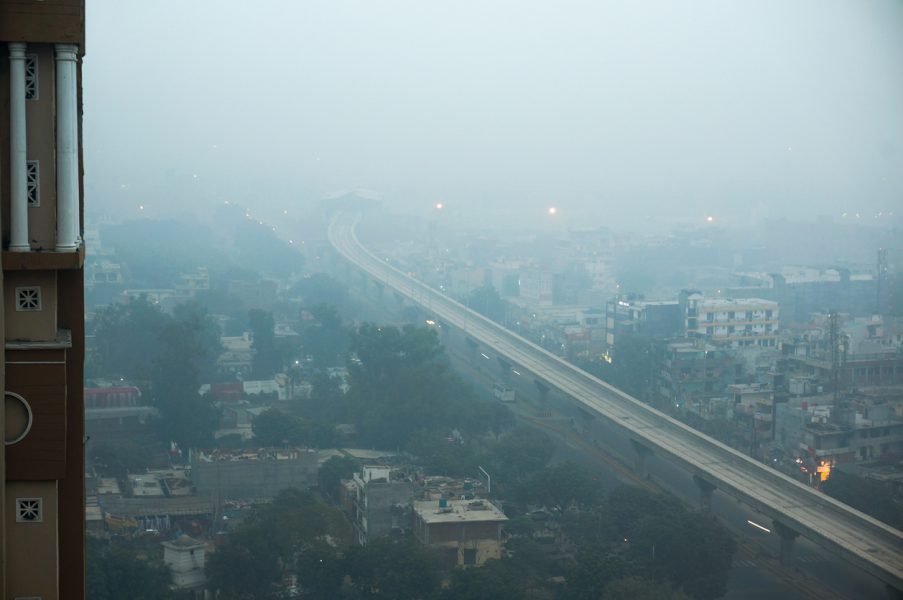
Biomass-combustion emissions behind particulate pollution in Delhi: Study

Natural and anthropogenic biomass burning are among the major sources of particulate pollution worldwide, affecting air quality, climate, and human health. Delhi, one of the world’s most populated cities, experiences severe haze events caused by particulate pollution during winter, but the underlying pathways remain poorly understood. A collaborative study led by the Indian Institute of Technology (IIT), Kanpur, has found that the high amount of particulate pollution in Delhi during nightly hours was caused by biomass-burning emissions.
Air pollution is responsible for estimated 18 per cent of India’s annual premature deaths. Delhi often experiences a high amount of particulate pollution, also termed haze; however, exact reasons behind their formation were hitherto unknown. The IIT Kanpur led study has shed new light on it.
Also read: At least one member of 80% Delhi families suffering from pollution ailments: Survey
“Here we observe intense and frequent nocturnal particle growth events during haze development in Delhi from measurements of aerosols and gases during January-February at the Indian Institute of Technology in Delhi. The particle growth events occur systematically despite the unfavourable condition for new-particle formation, including the lack of photochemical production of low-volatility vapours and considerable loss of vapours under extremely polluted conditions,” researchers explain.
Biomass burning affects 5% of world’s population
Prof. Sachchida Nand Tripathi, the principal investigator in the study, says, “The uncontrolled biomass burning for residential heating and cooking in the Indo–Gangetic plain gives rise to ultrafine particles, affecting the health of 5 per cent of the world’s population and impacting the regional climate. Regulating uncontrolled biomass-combustion emissions may help inhibit nocturnal haze formation and improve health.”
This study was designed for Delhi and conducted during the winter of 2018. Aerosol size distribution and molecular composition of ambient aerosols and gases were measured. Based on the measurements, growth of the aerosols during the night was calculated. Sources of aerosols and the sources of gases were also identified. Very high growth rates (tens of nanometers per hour) of aerosols, especially for those smaller than 100 nano meters (nanoparticles) were found in unfavourable new particle formation conditions compared to other places in the world. This causes haze formation within a few hours during extreme pollution events.
“The molecular information about aerosols clearly showed that organic vapours from biomass burning contributed to the growth of nanoparticles. It was also found that the composition of particles with sizes greater than 100 nano meter were dominated by ammonium and chloride species. Simultaneously, measurements of gases at molecular level showed that the biomass burning sources were their chief source which has preferential condensation on nano particles. Thermodynamic modelling of gaseous partitioning confirmed the observational findings,” reads the statement issued by IIT Kanpur.
Also read: Asthma, respiratory cases in children shot up in Delhi-NCR due to pollution: Report
Reducing uncontrolled combustion need of the hour
The study points out that reducing uncontrolled combustion, especially during conducive weather conditions, may limit the amount of supersaturated vapours available for nanoparticle growth and hence may be an effective strategy for the mitigation of nocturnal particulate numbers during haze in Delhi.
Apart from IIT Kanpur, the recently published findings in the journal Nature Geoscience is contributed by Physical Research Laboratory (PRL), IIT Delhi; Central Pollution Control Board (CPCB); Paul Scherrer Institute (PSI), Switzerland; and University of Finland and Helsinki. The research paper is co-authored by Suneeti Mishra and Prof. Sachchida Nand Tripathi, from the Department of Civil Engineering, IIT Kanpur. The co-authors are Vijay Punjaji Kanawade (IIT Kanpur) and Sophie L. Haslett (Stockholm University).
Also read: Delhi’s worsening air pollution sparks a meme fest on Twitter


